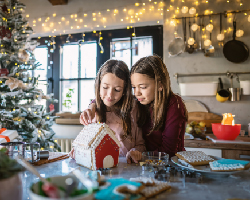
Dec. 10, 2021— Are you thinking of baking holiday cookies that sparkle with holiday fun? Maybe you found a recipe online that uses decorative glitter or dust—and it looks amazing. In that case, the U.S. Food and Drug Administration (FDA) cautions: Some of these showy ingredients may not be safe to eat.
To be clear, some glitter and dust products used in food-decorating are edible. They are specifically made for that purpose. It's OK to eat them. But some glitters and dusts sold online or in specialty stores are not intended to be used on food, according to FDA. Despite this, you might see baking videos, posts or articles that call for these inedible ingredients.
How to tell if a decorative ingredient is edible
The first step is to check the product's label. Most glitters and dusts that can be eaten say "edible" on the label. If it just says "non-toxic," that doesn't mean it's meant to be eaten.
What's more, edible dusts and glitters usually contain certain ingredients. Among them:
- Acacia (gum arabic).
- Color additives specifically approved for food use, including mica-based pearlescent pigments and FD&C colors, such as FD&C blue No. 1.
- Cornstarch.
- Maltodextrin.
- Sugar.
On some glitters and dusts, the label may just state "for decorative purposes only." Or there may not be an ingredients list. You shouldn't use these products to decorate foods you plan to eat.
A few more pointers to keep in mind:
- If you want to decorate baked goods with non-edible decorations, be sure to remove the inedible ingredients before you serve or eat it.
- When shopping for or exchanging baked goods, ask the baker if their decorative products are edible. You might ask to see the ingredients list if you want to be sure.
Don't let bad food spoil the good fun
Check out more food safety advice for the holidays and beyond.